
robot coupe U.S.A., Inc.
P.O. Box 16625, Jackson, MS 39236-6625
264 South Perkins St., Ridgeland, MS 39157
email: [email protected]
website: www.robotcoupeusa.com
1-800-824-1646
I. INTRODUCTION
II. ASSEMBLY/DISASSEMBLY INSTRUCTIONS
III. OPERATING INSTRUCTIONS
IV. PREVENTIVE MAINTENANCE GUIDE
V. TROUBLE SHOOTING AIDS
VI. SERVICE AGENCY LISTING
PARTS DRAWINGS & PART LISTS
ELECTRICAL SCHEMATICS
SERVICE AGENCY LIST
OPERATION MANUAL
FOR
Models
R502 Series E
Serial Numbers: 537xxxxx03
and
R602 Series E
Serial Numbers: 540xxxxx03
Also includes submodels R502Y,
R602Y, R502X and R602X
August 2009

R502 and R602 Operation Manual
Series E versions
2
Three phase motors may rotate either direction.
The required motor rotation is counterclockwise.
Check the rotation before attaching the cutter blades.
Changing the motor rotation requires a qualified electrician.
Also, see the note attached to the end of the power cord.
IMPORTANT NOTICE
3-PHASE MOTORS
DRIVE SHAFT ROTATION

R502 and R602 Operation Manual
Series E versions
3
I. INTRODUCTION
The Robot Coupe commercial food processor performs a host
of culinary feats. It is specifically designed for high speed and
quality vegetable processing. The Robot Coupe also provides
a wealth of safety and operating features to make volume food
preparation a pleasure rather than a chore.
This operators manual is broken down into sections giving
you detailed instructions for assembly and operation of the
continuous feed attachment and the cutter bowl attachment.
Close attention should be paid to all instructions in this manual
to ensure a long life and safe utilization of your food proces-
sor.
This manual should be kept within easy access
to all users for reference, and should be read
completely by all first time users of the machine.
CAUTION: Your Robot Coupe comes with sharp
cutting blades and or, cutting “Discs”. Always
handle with safety in mind. Always wear a pair
of cut-resistant gloves when handling any cut-
ting discs or blades.
Never put nonfood items in the machine.
NOTICE: If the machine fails to operate as de-
scribed in this manual, or if the machine mal-
functions in any way, remove the machine from
use and have it serviced. Additionally, discard
all food processed at the time of the malfunc-
tion.
Machine Specifications:
Models R502 and R602 are equipped with 2 speed motors that
plug into a standard 208/240 volt 60 Hz 3 phase power outlet.
The full load amperage rating is 2.6 amps on low speed and 2.8
amps on high speed. The machines are supplied with stain-
less steel bowls: the R502 with a five quart and the R602 hav-
ing a 7 quart bowl. Both machines are supplied with s-blade
and clear polycarbonate cover. The machines are supplied
with a continuous feed attachment and 2 cutting discs as
standard equipment. Additional cutting discs are available as
optional equipment.
CAUTION:
Always connect the Robot Coupe to a grounded
outlet with Ground fault circuit interrupter
(GFCI) protection device.
Disconnect the machine from the power outlet
when not in use and when cleaning or servic-
ing the unit.
Machine must be operated and stored in a lo-
cation not subject to water drips or spray or
explosive vapors.
The machine must not be modified in any way
from its original configuration.
Should the machine malfunction or should any
part be damaged, it must not be operated until
it is repaired by a qualified technician using only
genuine Robot Coupe® repair parts.
Operating times of 5 minutes or longer can
cause processed food to increase to tempera-
tures above 125 F.
Failure to follow operating instructions or at-
tempts to operate the machine outside its de-
sign limits may create a hazardous condition
that could damage the machine and /or injure
users.
The machine must be operated on a clean sturdy
counter or table. Keep the area around and
under the machine clear to allow air circulation.
Otherwise, the motor can overheat.

R502 and R602 Operation Manual
Series E versions
4
II. ASSEMBLY / DISASSEMBLY
INSTRUCTIONS
A. Assembling the Continuous Feed
Attachment
ALWAYS UNPLUG THE CORD DURING
ASSEMBLY AND DISASSEMBLY
STEP #1 Place the motor base assembly at a comfortable
height on a sturdy work surface. Remove the plastic discharge
plate from inside the continuous feed attachment. Place the
continuous feed attachment on the motor base with the re-
lease button at front center of the motor base assembly. Ro-
tate the attachment counterclockwise until it locks into place
with a snap action. When the attachment is in the proper
position, it should be level with the top surface of the motor
base assembly. NOTE: The machine will not operate cor-
rectly unless the continuous feed attachment is fully seated
and secured in place.
STEP #2 Place the discharge plate on the motor shaft with
the appropriate side up. Use the side with the small straight
fins for all julienne cuts or other delicate cuts. The large finned
side may be used for dicing or shredding. The product will not
exit the machine without the discharge plate.
Warning Wear cut-resistant gloves when
handling the cutting plates or the blade.
STEP #3 IF YOU ARE PREPARING TO SLICE OR
JULIENNE: Place the plate of your choice on the motor shaft
and turn clockwise until it drops into place and is fully seated.
The top of the plate should be just above the surface of the
continuous feed attachment.
STEP #4 IF YOU ARE PREPARING TO DICE OR USE A
FRENCH FRY COMBINATION: NOTE: The recessed rim
on the continuous feed attachment must be free from product
and clean so the grid can be firmly seated. The discharge
plate must be in the machine or the product will not exit.
With the tab on the plastic grid aligned with the cutout in the
Continuous Feed Attachment, place the plastic grid onto the
recessed rim of the Continuous Feed Attachment. Put the
appropriate slicing plate on top of the dicing grid with the stem
of the plate DOWN. NOTE: Only those slicing plates de-
signed with a locking “L” shape slot can be used in conjunc-
tion with a dicing grid. Never attempt to use a “regular” slicing
disc (1mm, 2mm, 3mm) in conjunction with a dicing grid as it
may cause damage to the continuous feed lead and/or the
pusher (see chart on page 7). Rotate the disc until the cutout
in the stem drops into place on the motor shaft pin. Continue
rotating the disc a full turn. If rubbing occurs,
DO NOT PROCEED-call your service agency.
STEP #5 Place the continuous feed lead on the continuous
feed attachment and secure in place with the holding pin. The
lead should fit flush on the continuous feed attachment.
B. Disassembly of the continuous feed
attachment
STEP #1 Turn the unit off and unplug the power cord from
the wall outlet.
STEP #2 Pull out the hinge pin from continuous feed lead
and lift the latch at upper right front of machine and remove
the continuous feed lead.
STEP #3 Remove the cutting disc. Wear cut-resistant gloves.
Rotate the disc slightly counterclockwise, then lift up and off of
the motor shaft. Remove the dicing or French fry grid (if any)
then, lift out the plastic discharge plate.
STEP #4 Press the release button on the continuous feed
attachment and at the same time turn the continuous feed
clockwise . The continuous feed releases and can be lifted
off over the motor shaft.
Dicing Combination
Assembly
French Fry Combination
Assembly

R502 and R602 Operation Manual
Series E versions
5
C. Assembling the Cutter Bowl Attachment
1. The cord should always be unplugged during assembly
and disassembly.
2. With the handle turned to the front, put the bowl down on
the motor base. Turn the bowl handle to the left of center
and the bowl should drop into place level with the top of the
motor base.
3. Turn the handle back to the right until it comes to a stop
and is centered with the front of the motor base.
4. Put the blade on the motor shaft and turn until it drops
into place. The bottom blade should be parallel to and
almost touching the bottom of the bowl.
5. With the long tab on the bowl lid turned to the left of
center, put the lid on the bowl and turn counterclockwise
until it stops. The long tab should be centered over the
bowl handle.
6. DO NOT OPERATE THE MACHINE UNLESS IT IS
PROPERLY ASSEMBLED AND THE LID IS FULLY
SEATED AND CENTERED OVER THE BOWL!
D. Disassembly of the cutter bowl attachment.
STEP #1 Turn the machine OFF and UNPLUG it.
STEP #2 Rotate bowl lid clockwise and lift off.
STEP #3 Remove the blade assembly.
STEP #4 Locate the release trigger on the lower back portion
of the bowl handle. Pull the trigger and, at the same time,
turn the bowl clockwise and lift free.
E. Blade Assembly / Disassembly
The blade should be disassembled and cleaned at least
once a day and after each day’s use.
R502 Blade:
1. Unplug the cord and wear cut-resistant gloves!
2. There is a removable cap in the top of the Blade. The cap
should be removed before cleaning. To remove the cap, push
a long blunt object such as a screwdriver, through the bottom
of the blade, and knock out the top cap.
R602 Blade:
1. Unplug the cord and wear cut-resistant gloves!
2. Locate the blade tool shipped with your machine and put
it down over the motor shaft with the raised stop facing the
front of the machine.
3. Put the blade on the motor shaft so that the center of the
blade assembly rests flat on the blade tool. Insert the metal
bar into one of the holes in the blade cap.
4. Turn the blade cap clockwise to tighten or counterclock-
wise to loosen. The bottom blade should hit the stop on the
blade tool which prevents the assembly from turning. Do
not overtighten.
Continued next page

R502 and R602 Operation Manual
Series E versions
6
III. OPERATING INSTRUCTIONS
A. Operation of the Continuous Feed Attachment
THE UNIT SHOULD BE IN THE OFF POSITION EXCEPT
WHEN PROCESSING IS UNDERWAY. It is recommended
that the machine be operated on a 50% duty cycle. This is
easily accomplished since the preparation time (cleaning, cor-
ing, peeling, and loading) takes longer than the processing
time.
If necessary, cut products to fit the chosen opening. Use the
small round opening for (carrots, cucumbers, etc.).
Always use the food pushers to force the prod-
uct through the openings.
Constant pressure with the pusher will yield a consistent out-
put. More pressure will increase the thickness of the product,
while light pressure will result in a thin product. If no pressure
is applied, the result is sometimes inconsistent. When the
pusher comes to a stop, push the off button and reload the
entry port.
Note: Application of too much pressure will
increase the motor load without increasing the
amount of product being cut.
DO NOT remove the continuous feed lead when
the motor is running. Wait until the motor has
come to a full stop.
DO NOT put anything other than food products
inside the entry or exit port.
DO NOT attempt to run frozen products through
the cutting plates.
(1) Slicing Operation:
The vegetables must be prepared so that they will fit into the
chosen entry port. Produce such as carrots, cucumbers, etc.,
should be “squared” at both ends. This will provide a consis-
tent slice throughout the whole product. Remove the core
from cabbage and lettuce and cut into halves or thirds to fit in
the large entry port.
(2) Grating Operation:
Vegetables must be prepared so that they will fit into the cho-
sen entry port.
Use cold cheese and apply a fine coating of cornstarch before
grating to keep the finished product from sticking together.
The cornstarch will not be visible and is tasteless. Grating
cheese can cause overheating of the motor if not grated in the
recommended manner. It is recommended that a slight pul-
sating pressure be applied with the pusher, alternating slight
pressure then no pressure. Prepare the cheese in volumes
that will permit motor cool down time during long production
runs.
(3) Dicing Operation: The dicing operation requires that prod-
uct be sliced both horizontally and vertically. The smaller the
dice required, the more difficult the cut is to achieve. Soft or
juicy produce will tend to mush if the dice is too small or the
produce is too soft.
Do not attempt to dice meats or cheeses.
Damage could occur to the blades and/or the motor that will
not be covered under warranty.
During the dicing operation, attention should be given to the
finished product. A visible change in the product will occur
when the dicing grid requires cleaning eg., more liquid. The
best way to clean the grid is to remove it from the machine
and force any produce on the grid through with a stiff bristle
brush.
(4) Julienne Operation: Insertion of the product to be cut must
be horizontal if a long “stick” is to be achieved, e.g. julienne
zucchini for sauté. Vertical insertion will result in finely chopped
products, e.g. celery. A finely chopped onion product may
also be obtained with this operation by quartering the food
and letting it gravity feed.
Do not attempt to julienne meats or cheeses.
THE BLADE ASSEMBLY
SHOULD BE TAKEN
APART AND CLEANED
AT LEAST ONCE A DAY.
APPLY SOME FOOD-
GRADE GREASE OR OIL
TO THE R6N ASSEMBLY
TO EASE DISASSEM-
BLY.
5. Assemble the blades as shown, with the small nylon
spacer directly under the top locking nut. The blades
should be installed beveled side up. The correctly assembled
blade looks like the letter “S”.

R502 and R602 Operation Manual
Series E versions
7
B. DISC UTILIZATION:
The standard machine comes with two (2) discs. Check your
most current price list for which discs are included as stan-
dard. User applications may require additional discs. The
Robot Coupe processor will perform a variety of functions: slic-
ing grating dicing, and julienne. There are a total of 34 different
discs available to perform these functions (see below). The
number and type of discs required will vary, depending upon
the planned utilization.
10 slicing discs
8 grating discs
7 dicing combinations
8 julienne discs
3 wave slicing discs
2 straight French fry kits
The ten (10) slicing discs range form 1mm (approx. 1/64") to
25mm (approx. 1"):
Part Number MM Slicing Inches (Approx.)
28062 1mm 1/32"
28063 2mm 5/64"
28064 3mm 1/8"
28004 4mm 5/32”
28128 5mm 3/16"
28129 8mm 5/16"
28130 10mm 3/8"
28131 14mm 9/16"
28132 20mm 25/32"
28133 25mm 1"
The 28062 (1/32") slicing disc offers a very fine cut. A pos-
sible use for such a fine cut is the preparation of Japanese
style vegetables. Typically these products (such as carrots or
celery) will be placed in the pusher horizontally to obtain a long
thin product.
The 28063 (5/64") slicing disc finds a variety a application.
Cabbage may be sliced with this disc for New York Style Cole
Slaw. Carrot curls which adorn many dishes can be achieved
with this slicer. The carrot slices should be dropped into cold
water to permit curling. A nice carrot coin for salads can also
be obtained.
The 28064 (1/8") slicing disc is ideal for salad bars i.e.., cu-
cumber slices, carrot “coins” (vertically sliced Carrots). Let-
tuce sliced by this disc is readily used with sandwiches, tacos,
etc.
The 28004 (5/32") and 28128 (3/16") slicing discs are also
ideal for salad bar use, for the stock pot where thicker “man”
size cuts are desired. This blade is excellent also for orange
or lemon slices as well as tomatoes, where a nice smooth
surface is desired. NOTE: You can not slice meats or cheeses
on any food processor.
The 28128, 28129, 28130, 28131,28132, and 28133 slicing
discs are used in conjunction with the dicing grids. In addition
thicker slices can be obtained for use in soups and stews.
The 28133 (1") slicer also provides an excellent cut of lettuce
for use in a salad.
There are eight grating discs available for use with the R6:
Part Number Size MM Inches (Approx.)
28055 X-Fine
28061 Hard cheese
28056 1.5 mm 1/16"
28057 2 mm 5/64"
28058 3 mm 1/8"
28136 4 mm 5/32"
28163 5 mm 3/16"
28164 7 mm 5/16"
28165 9 mm 3/8"
The 28061 hard cheese grating disc is designed specifi-
cally to grate Parmesan or Romano cheese. CAUTION: Softer
cheese will tend to gum up the plate. The grated product is
very fine. This disc can be used for making cracker or cookie
crumbs. Dried bread crumbs can be obtained CAUTION: the
moisture in fresh bread will cause clogging and poor results.
Use of either the 28057, 28058, or 28163, fine, medium, and
coarse grating discs are much dependent upon personal choice
and specific application. The medium and coarse grating discs
offer a quality grated product with cheese, carrots, cabbage for
cole slaw, etc.
A diced product requires two actions. First, a horizontal slice
is made and then this slice is forced by the machine through
the dicing grid to obtain a vertical cut. This results in a cubed
product. The dimensions of this cube are varied via the se-
lection of the slicing plate and dicing grid. The following slic-
ing discs can be used with any of the dicing grids:
dicing
grid 5x5 mm 8x8 mm 10x10 mm 14x14 mm 20x20 mm 25x25 mm
Plate
5 mm 28110
8 mm 28111
10 mm 28112
14 mm 28113
20 mm 28114
25 mm 28115
The shaded areas indicate additional combinations that can be used.
The 5mm dicing combination is generally used for potatoes
and squash because of its small size.
The 8mm smaller dicing combinations can be used for finely
diced carrots, celery, etc. and readily used in soups or stews.
The larger (14 mm or greater) dicing combinations work well
with fruits such as apples, pears, pineapple, etc.

R502 and R602 Operation Manual
Series E versions
8
When dicing tomatoes, green peppers, onions, or celery al-
ways insure that the product is introduced into the machine so
that the slicing disc will be slicing across the grain of the veg-
etable.
CAUTION: The softer the produce, the less acceptable will
be the finished product.
After a time of use, the dicing grid will require cleaning. A
visible difference in the finished product will occur when clean-
ing is required. The best way to clean the grid is: remove the
slicing plate, take a stiff bristle brush and force the product
that is on the grid to go through.
There are seven Julienne discs available:
28051 2 x 2 mm (5/64")
27072 2 x 4 mm (5/64" x 5/32")
27066 2 x 6 mm (5/64" x 1/4")
27067 2 x 8 mm (5/64" x 5/16")
28101 3 x 3 mm (1/8”)
28052 4 x 4 mm (5/32")
28053 6 x 6 mm (1/4")
28054 8 x 8 mm (5/16")
Products such as julienne carrots, chopped celery and finely
chopped onions are obtainable as well as julienne celery roots.
DO NOT ATTEMPT TO JULIENNE MEATS OR CHEESES!
There are three wave slicing discs:
Part Number MM Slicing Inches (Approx.)
27068 2mm Waved 5/64"
27069 3mm Waved 1/8"
27070 5mm Waved 3/16"
The waved slicing discs work just like the straight slicing discs,
except that the product has waved or ruffled sides. This can
be an attractive alternative to the flat slices that are so preva-
lent on salad bars. By adding a waved plate you can dramati-
cally alter the presentation of the food. As with the straight
slicing discs remember that harder foods slice best when cut
thinner and softer foods slice best when cut thicker.
C. Operation of the Cutter Bowl Attachment
The cutter bowl attachment is used for chopping, grinding,
pureeing, blending, mixing, and kneading of ingredients re-
quired in most every recipe.
With the power switch off and the bowl and blade secured in
place (per previous instructions) you are now ready to add
product to the bowl. Place the product in the bowl not over
3/4 full and rotate the cover to secure it in place. The bowl is
operated using a quick start - stop action by alternately press-
ing the on and off switches. Control and consistency can be
better achieved in this manner. Remember, if you start with a
consistent product your end product will also be consistent.
TO CHOP MEAT: Place meat (precut 1 to 2 inches square) in
the bowl. Fill approximately 1/3 to 1/2 full (no more than
2-1/2lbs.) Rotate the lid locking it in place, quickly start and
stop the motor using the on\off switches. Repeat this pro-
cess until product is the desired consistency.
TO CHOP HARD CHEESE: Place 1 to 2 inch portions of well
chilled cheese into the bowl (not over 2 1/2 pounds). With the
lid locked in place quickly start and stop the motor. Continue
this process until you have reached the desired consistency.
For powdered cheese, simply proceed as above until the par-
ticles in the bowl are about pea size then start the unit and
allow the blades to run continuously until you have a fine pow-
der.
TO CHOP ONIONS, CELERY, CABBAGE, CARROTS. etc.
Quarter onions, and cut other vegetables into 2 to 3 inch
pieces. Proceed using a quick start - stop action until the
desired consistency is achieved.
TO PUREE OR MIX: To puree tomatoes, make sauces, or to
mix and blend, place the ingredients in the bowl, turn the unit
on, and allow it to run until the desired consistency is reached.
TO MAKE MAYONNAISE: Place 6 eggs, 3 tsp. of salt, 3 tsp.
of sugar, 2/3 tsp. of dry mustard, a pinch of white pepper and
a pinch of red pepper, in the bowl. Turn the unit on, and begin
adding 2 qt.. of oil pouring very slowly through the top allow-
ing the stream of oil to fall on the top of the cutter blade. When
you have added 1/2 of the oil, pour in 4 oz. of vinegar and the
balance of the oil. After all of the oil has been added let the
machine run for 20 seconds longer. The mayonnaise is now
homogenized.
TO MAKE BREAD CRUMBS: Place torn fresh or dried bread
in the bowl, and quickly start and stop the unit. Continue this
process until you reach the desired consistency or allow the
unit to run continuously for fine powered bread crumbs used
in stuffing mix.

R502 and R602 Operation Manual
Series E versions
9
D. GENERAL HINTS:
1. Be sure your Robot Coupe is properly assembled before
using.
2. Always insure blade and attachment are tightly in place.
3. Do not fill the cutter bowl over 3/4 full.
4. Learn to operate the cutter bowl using a start - stop
motion so the consistency of the prepared product can
be controlled. Remember it is important to start with
uniform pieces for uniform results.
5. Wash the bowl, blade and cover after every use. Do not
store food in the bowl.
6. If the motor does not start when the switch is on and lid
is fully in position, disengage the lid (machine is now off)
and check to see if the attachment is locked in place. If
okay, unplug the unit and see if any food is jamming the
blade.
7. If the machine malfunctions for any reason, discard any
food being processed at that time.
IV. PREVENTIVE MAINTENANCE/TROUBLE
SHOOTING AIDS:
The Robot Coupe has been designed to provide maximum
trouble free performance. Adherence to the assembly and
operating instructions will further assure good performance.
Additionally, if simple common sense rules are applied, a long
life utilization will be achieved.
(1) Care: While the Robot Coupe is a ruggedly constructed
machine, overall handling should be accomplished with a
sense of use rather than abuse. The continuous feed attach-
ment and the motor housing are made of rugged cast alumi-
num and will yield a long life if not mistreated. While the ma-
chine is reasonably portable, care should be taken not to drop
it. Remove the continuous feed and any plates or other at-
tachments before relocating the machine. Your Robot Coupe
should never be picked up by the continuous feed lead the
bowl or the cord. Always lift from the bottom of the motor
base assembly. Care should be exercised in relocating it.
Equal caution should be exercised in handling all of the parts
to assure they are not subject to undue force.
(2) Cleaning: Proper cleaning of the machine is one of the
most important preventive maintenance measures the user
can employ. The high acid content of food can cause harm to
electrical parts contained within the housing. Although these
elements are isolated from the outside through seals, veg-
etable juices will tend to seep. If vegetable juices are permit-
ted to collect on the machine over periods of use, erosion of
the seals can occur. It is recommended that the machine be
cleaned after each operational use, and at least once per day.
Correct cleaning procedures are required to assure that dam-
age is not inflicted in the cleaning process. The motor sup-
port/base assembly contains the motor and electrical compo-
nents.
DO NOT IMMERSE THE MOTOR BASE
ASSEMBLY IN WATER.
While the continuous feed lead, pushers and discs are dish-
water safe , some additional cleaning may be required. Clean-
ing of the discs should be accomplished with care to help pre-
vent cuts. A stiff bristle brush will be effective in knocking the
food out of the crevices.
Cleaning of the motor/base assembly must be done with care.
First, unplug the unit. A sponging with a soluble detergent is
acceptable, making sure the water is not permitted to pen-
etrate the seals. Clean around the seals with a small brush,
taking care to remove all food. Clean the motor shaft with a
small brush.
Read the label for the dish machine detergent you are using
to determine if it is safe for soft metals. If you can not deter-
mine if it is safe for soft metals, then contact your supplier for
this information. Many other cleaning detergents can also
cause corrosion of soft metals.
Do not wash the aluminum parts of this machine using a non-
metal safe detergent either in a dish machine or pot sink! Clean
the aluminum feed attachment using only soft metal safe de-
tergents.
While the continuous feed lead, pushers and discs are dish-
washer safe if used with a metal safe detergent, some addi-
tional cleaning may be required. Cleaning of the plates should
be accomplished with care to help prevent cuts. A stiff bristle
brush will be effective in knocking the food out of the crevices.
The “S” blade assembly should be taken completely apart
and washed after each days use for sanitary reasons, and
also to prevent the parts from becoming jammed or “freezing
up”. Follow the previous assembly/disassembly instructions
carefully and wear cut-resistant gloves when han-
dling the cutting blades.
(3) Preventive Maintenance: In addition to cleaning the seals,
an examination should be made periodically to insure that a
seal against food is being maintained. With proper care, and
depending on use, the seals should last for a year or more.
However, they can and should be replaced when wear or ero-
sion is noted. It is recommended that the seals be replaced
by an authorized repair agency.
Good operational performance is obtained when the blades
are sharp. Continued use can dull the blades. All of the slic-
ing and grating discs are made so that the blade can be re-
placed when they become dull. Always store the disc in the
disc holders. Additional disc holders can be obtained from
your food service distributor.

R502 and R602 Operation Manual
Series E versions
10
Sharpening The Blade on The Cutting Disc
ALWAYS WEAR CUT-RESISTANT GLOVES
WHEN HANDLING THE BLADES
The blades can be sharpened professionally if you prefer.
1. Put on your cut-resistant gloves.
2. Using a screwdriver, remove the 2 or 3 screws holding
the slicing blade to the aluminum disk.
IMPORTANT: SOME SCREWS ARE LONGER THAN
OTHERS.
Note the hole from which each screw is removed. Reinstall
all screws to their original positions.
3. Use the robot coupe stone or any good sharpening
stone.
4. Hold the blade, bevel side up, flat on the edge or corner
of a sturdy table.
5. With the other hand hold the stone at a 30-45 degree
angle against the top bevel of one blade.
6. Pull the stone into the blade edge moving from hub to tip,
several strokes, until the blade is sharp.
7. Turn the blade over and rub the stone flat against the
underside of the blade to remove the feather edge
formed at step 5.
8. Wash the blade before reinstalling the blade in the
aluminum disk.
9. Reinstall all screws to their original positions.
Sharpening The “S” Blade
ALWAYS WEAR CUT-RESISTANT GLOVES
WHEN HANDLING THE BLADES.
1. Put on your cut-resistant gloves.
2. Use the robot coupe stone or any good sharpening
stone.
3. Hold the blade flat on the edge or corner of a sturdy
table.
4. With the other hand hold the stone at a 30 degree angle
against the top bevel of one blade.
5. Pull the stone into the blade edge moving from hub to tip,
several strokes, until the blade is sharp.
6. Turn the blade over and rub the stone flat against the
underside of the blade to remove the feather edge
formed at step
7. Repeat the procedure for the other blade.
8. Wash the blade before use.
In general, the best preventive measure that can be applied
is close adherence to the assembly and operator’s instruc-
tions along with common sense. Make sure the continuous
feed assembly is fitted on flush before operating the machine.
Your Robot Coupe is a piece of kitchen equipment and like all
other kitchen equipment, extreme care and caution should
be used when operating. Although training requirements are
minimal, only responsible and reasonably prudent individuals
should be allowed to operate your Robot Coupe.
DO NOT remove the attachments from the
base when the motor is running.
DO NOT put your hands, utensils, or anything
other than the object to be processed into
the openings or exit chute.
DO NOT overload or overfill the bowl with
product.
DO NOT immerse the motor base in water.
DO NOT allow the machine to run unattended.
DO NOT use excessive force with the pusher.
DO NOT remove the continuous feed lead
attachment when the motor is running.
Wait until the motor has come to a full stop.
DO NOT lift the machine by anything other
than the motor base.
DO NOT operate a machine unless it is com-
pletely assembled and all parts including
the feet are properly attached.

R502 and R602 Operation Manual
Series E versions
11
V. TROUBLE SHOOTING AIDS
The following section indicates potential problems and the cor-
rect solution which should be implemented by users. Prob-
lems which extend beyond these will require an experienced
repairman. A list of the authorized service agencies is sup-
plied.
A. Unit does not start
1. Are all the attachments tightly in place? Be sure the
continuous feed lead is flush with the
continuous feed attachment. Bowl: Is the long bowl lid
tab fully in place over the handle. Try again.
2. Press the off button and unplug the unit.
3. Remove continuous feed lead or bowl.
4. Remove any product from inside the attachment.
5. Is there any product jamming the disc or the blade?
Always wear cutting gloves when
handling the discs or blades.
6. Try another outlet.
B. Continuous feed lead will not fit flush with motor base.
1. Processing disc is not in its proper position.
2. Rim of disc should be slightly above the upper edge of
continuous feed attachment.
C. Unit stops running during (while) processing.
1. Turn unit off and unplug it.
2. Follow A. above and try again.
D. If unit does not operate after following above
1. Check outlet for current (breaker for fuse).
2. Try unit again.
3. Call local service agency.
E. Unit starts to spark or smoke.
1. Turn unit off and unplug it, call local authorized service
agency.
F. Unit Makes grinding noise.
1. Turn off unit, disassemble, check continuous feed lead
and processing plate to see if they have
been rubbing together.
2. If this was the case the processing disc was not fully
seated. Check for food particles inside stem of
processing disc. Replace disc insuring that processing
disc is fully seated. Make sure there are no food
particles on the motor shaft.
G. Food is going into machine, but not coming out.
1. Discharge Plate is not in unit.
H. Cucumbers coming out with torn skins.
1. The Blade is dull and must be changed. NOTE:
cucumber condition before processing should be
considered.
2. Make sure the small “vane” side of the discharge plate
is up.
VI. SERVICING OF YOUR ROBOT COUPE
Your Robot Coupe has a one year limited warranty against
defects in parts and workmanship. Should the unit require
service, check with your distributor to see where local service
is available. If not or if you wish your unit to be serviced at the
factory, call for a return merchandise authorization (RMA)
number, and upon receipt of same, ship it PREPAID and in-
sured to our factory address.
Robot Coupe USA, Inc. Service Dept.
Phone: 1-800-824-1646
601-898-8411

R502 and R602 Operation Manual
Series E versions
12

R502 and R602 Operation Manual
Series E versions
13







U.S.A., Inc.
P.O. Box 16625, Jackson, MS 39236-6625
280 South Perkins St., Ridgeland, MS 39157
email: info@robotcoupeusa.com
website: www.robotcoupeusa.com
1-800-824-1646
ROBOT COUPE U.S.A., INC. LIMITED WARRANTY
YOUR NEW ROBOT COUPE PRODUCT IS WARRANTED TO THE ORIGINAL PURCHASER
FOR A PERIOD OF ONE YEAR FROM THE DATE OF PURCHASE
This LIMITED WARRANTY is against defects in the material and/or workmanship, and includes labor for replacement
of defective parts, provided repairs are performed by an authorized service agency (see attached list). The CUSTOMER
must inform the Service Agency of the possibility of warranty coverage and provide a copy of the dated sales or delivery
receipt BEFORE WARRANTY REPAIRS ARE BEGUN. Replacement parts and accessories are warranted for ninety
(90) days from the date of purchase when purchased separately and will be verified by dated sales receipt OR packing
slip which list that item. All parts or accessories replaced under warranty must be returned to the Service Agency.
THE FOLLOWING ARE NOT COVERED UNDER WARRANTY.
1. Damage caused by abuse, misuse, dropping, or other similar incidental damage caused by or asresult of
failure to follow installation, assembly, operating, cleaning, user maintenance or storage instructions,
including failure to verify and correct rotation of three phase motors.
2. Labor to sharpen and/or parts to replace knife assemblies or blades which have become dull, chipped, or
worn due to normal use.
3. Material or labor to renew or repair scratched, stained, chipped, dented, or discolored surfaces, blades,
knives, attachments, or accessories.
4. Transportation charges to or from an authorized service agency for repairs of a machine designated as
“CARRY IN SERVICE’ (Table Top Models).
5. Labor charges to install or test attachments or accessories (i.e. bowls, cutting plates, blades, attach-
ments) which are replaced for any reason.
6. Charges to change Direction-of-Rotation of Three Phase electric motors (INSTALLER IS RESPON-
SIBLE). All Robot Coupe products must operate counterclockwise.
7. SHIPPING DAMAGE IS NOT COVERED BY WARRANTY. Visible and hidden damages are the
responsibility or the freight carrier. The consignee must file a damage claim promptly against the
carrier, or upon discovery in the case of hidden damage.
KEEP ALL ORIGINAL CONTAINERS AND PACKING MATERIALS
FOR CARRIER INSPECTION
Robot Coupe U.S.A., Inc., Robot Coupe S.A., or any of their affiliates, distributors, officers, directors, agents,
employees or insurers will not be obligated for consequential or other damages, losses, or expenses in connection
with or by reason of the use of or the inability to use the machine for any purpose.
-
 1
1
-
 2
2
-
 3
3
-
 4
4
-
 5
5
-
 6
6
-
 7
7
-
 8
8
-
 9
9
-
 10
10
-
 11
11
-
 12
12
-
 13
13
-
 14
14
-
 15
15
-
 16
16
-
 17
17
-
 18
18
-
 19
19
-
 20
20
Robot Coupe R502X Operating instructions
- Type
- Operating instructions
Ask a question and I''ll find the answer in the document
Finding information in a document is now easier with AI
Related papers
-
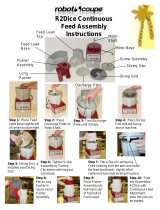 Robot Coupe R2Dice Assembly Instructions
Robot Coupe R2Dice Assembly Instructions
-
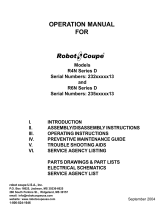 Robot Coupe R4N Operating instructions
Robot Coupe R4N Operating instructions
-
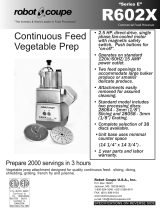 Robot Coupe R602X Datasheet
Robot Coupe R602X Datasheet
-
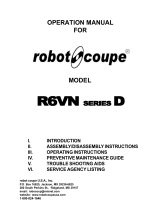 Robot Coupe R6VN Operating instructions
Robot Coupe R6VN Operating instructions
-
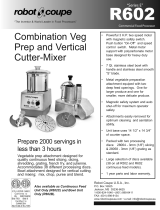 Robot Coupe R602 Datasheet
Robot Coupe R602 Datasheet
-
Robot Coupe R302V Operating instructions
-
Robot Coupe R302V Operating instructions
-
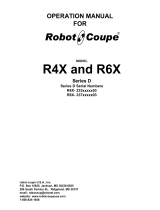 Robot Coupe R4X Operating instructions
Robot Coupe R4X Operating instructions
-
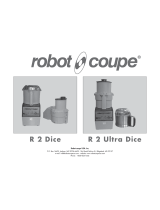 Robot Coupe R 2 Dice User manual
Robot Coupe R 2 Dice User manual
-
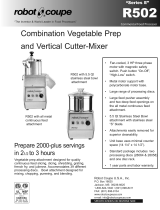 Robot Coupe R502 Datasheet
Robot Coupe R502 Datasheet
Other documents
-
Tylö Floor grating Reflection#hs_cos_wrapper_module_170083095099527 .icon-style--link .g-module-macros-icon { padding-left:8px; } #hs_cos_wrapper_module_170083095099527 .icon-style--link .g-module-macros-icon svg { fill:#C65622; } Owner's manual
-
Hamilton Beach 70825 User manual
-
KitchenAid KFP1642 Instructions Manual
-
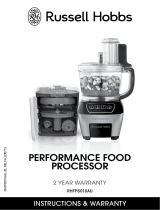 Russell Hobbs rhfp6010 User manual
Russell Hobbs rhfp6010 User manual
-
KitchenAid KFP1642 User manual
-
KitchenAid KFP1642MS0 Owner's manual
-
Black & Decker SL3000B User manual
-
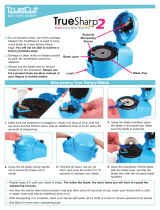 Grace Company TrueSharp 2, TrueSharp Power Rotary Blade Sharpener Operating instructions
Grace Company TrueSharp 2, TrueSharp Power Rotary Blade Sharpener Operating instructions
-
Witt Salad Maker Owner's manual
-
Berkel 829E User manual





























